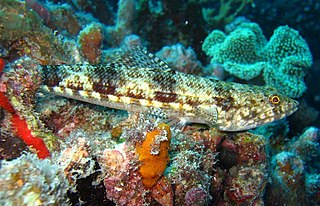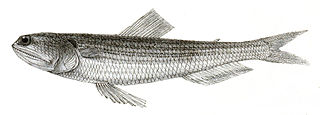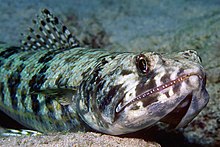
Aulopiformes is a diverse order of marine ray-finned fish consisting of some 15 extant and several prehistoric families with about 45 genera and over 230 species. The common names grinners, lizardfishes and allies, or aulopiforms are sometimes used for this group. The scientific name means "Aulopus-shaped", from Aulopus + the standard fish order suffix "-formes". It ultimately derives from Ancient Greek aulós + Latin forma, the former in reference to the elongated shape of many aulopiforms.
The arrowtooth lizardfish is a lizardfish of the family Synodontidae, found in isolate locations across the southwestern Pacific, at depths of between 9 and 200 m. Its length is between 15 and 28 cm.

The inshore lizardfish is a member of the family Synodontidae found in the western Atlantic.

Synodus is a genus of fish in the family Synodontidae found in Atlantic, Indian, and Pacific Oceans.

The variegated lizardfish is a lizardfish of the family Synodontidae found in the western Pacific and Indian Oceans, at depths from 4 to 90 m. It can reach a maximum length of 40 cm.

Trachinocephalus myops, also known as the blunt-nose lizardfish, is a species of fish in the family Synodontidae found in Atlantic Ocean. This species grows to a length of 40 centimetres (16 in) TL. It has been discovered that the species has two peaks in its spawning season, from February to April and from August to October. This suggests that their reproductive activity is suitable for the different environments the species utilizes.

The Bathysauridae are a small family of deepwater aulopiform fish, related to the telescopefishes. The two species in the family both belong to the genus Bathysaurus. Commonly called deepwater lizardfishes or deepsea lizardfishes, the latter name usually refers to the species B. ferox specifically.

Synodus intermedius, the common sand diver, is a species of fish in the lizardfish family, the Synodontidae, a basal ray-finned fish in the class Actinopterygii. Sand divers inhabit subtropical marine ecosystems, (37-17°N), including sandy- bottom areas on continental shelves, coral reefs, estuaries, bays, and reef structures. They are demersal or benthic fish, which means they live on or close to the sea bed. Distribution ranges from the northern Gulf of Mexico south to the Guianas, and western Atlantic north to North Carolina and Bermuda. They are a common lizardfish in the West Indies. They grow to about 40 cm (16 in) total length, and weigh around 1 kg (2.2 lb).

The California lizardfish is a species of lizardfish primarily inhabiting the Californian coast. It has a long, brown body, which offers it camouflage in its habitat, the sandy bottom of the ocean. From its hiding spot on the bottom it ambushes small fish and squid. California lizardfish are oviparous and are believed to spawn in the summer months.

Saurida undosquamis, the brushtooth lizardfish, large-scale grinner or largescale saury, is a type of lizardfish, a demersal species that occurs in the Eastern Indian Ocean, Malay Peninsula, northern Java, Arafura Sea, Louisiade Archipelago, southern Philippines and northern Australia,. Reports of its occurrence in the Red Sea region and introduction to the Mediterranean are questionable,.
The orangemouth lizardfish is a species of lizardfish that lives mainly in the Eastern Central Pacific.

The smallscale lizardfish(Saurida caribbaea) is a species of lizardfish that lives mainly in the Western Atlantic.
Synodus oculeus is a species of lizardfish that lives mainly in the Western Pacific.
Synodus lobeli, Lobel's lizardfish, is a species of lizardfish that lives mainly in the Northwest Pacific Ocean.

The lighthouse lizardfish(Synodus jaculum) is a species of lizardfish that lives mainly in the Indo-Pacific.

The sand lizardfish, clearfin lizardfish or variegated lizardfish is a species of lizardfish that lives mainly in the Indo-Pacific.

Saurida is a genus of fish in the family Synodontidae.
Synodus macrostigmus, commonly known as the largespot lizardfish, is a species of fish in the lizardfish family, Synodontidae, a basal ray-finned fish in the class Actinopterygii. It is native to the warm temperate western Atlantic Ocean and the Gulf of Mexico.
Synodus mundyi is a lizardfish of the family Synodontidae, found in the Hawaiian Islands, at depths of between 9 and 200 m. Its length is between 15 and 28 cm.
The Lessepsian lizardfish is a species of marine ray-finned fish belonging to the family Synodontidae, the lizardfishes. This species was first formally described in 2015 by Russell, Golani and Tikochinski from the Israeli part of the Red Sea. This species is found in the Indian Ocean from South Africa north to the Red Sea and east to the Andaman Sea. It has entered the Mediterranean Sea, probably through the Suez Canal as a Lessepsian migrant and is now a commercially important species for fisheries in the eastern part of that sea. This species was previously thought to have been either S. undosquamis or S. macrolepis.













